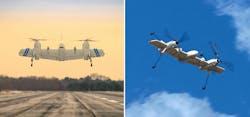Sikorsky's rotor blown wing UAS flies in helicopter and airplane modes
STRATFORD, Conn. - Sikorsky, a Lockheed Martin company in Stratford, Conn., announced it has successfully validated advanced control laws for a "rotor blown wing" uncrewed aerial system (UAS), demonstrating stable flight in both helicopter and airplane modes.
The battery-powered, 115-pound twin prop-rotor prototype has completed extensive flight testing, proving its maneuverability across various flight regimes. The vertical takeoff and landing (VTOL) design has potential scalability for larger aircraft requiring hybrid-electric propulsion.
“Combining helicopter and airplane flight characteristics onto a flying wing reflects Sikorsky’s drive to innovate next-generation VTOL UAS aircraft that can fly faster and farther than traditional helicopters,” said Sikorsky Vice President and General Manager Rich Benton.
The aircraft, developed by Sikorsky Innovations, has undergone a yearlong testing process, progressing from preliminary design to flight trials. In January, the 10.3-foot composite wingspan prototype completed more than 40 takeoffs and landings, including 30 transitions between helicopter and airplane modes—the most complex maneuver of the design. It reached a top cruise speed of 86 knots in horizontal flight. Simultaneous wind tunnel testing on a full-scale model validated the control laws with real-world data.
“Our rotor blown wing has demonstrated the control power and unique handling qualities necessary to transition repeatedly and predictably from a hover to high-speed wing-borne cruise flight, and back again,” said Sikorsky Innovations Director Igor Cherepinsky. “The data indicates we can operate from pitching ship decks and unprepared ground when scaled to much larger sizes.”
Future applications for the rotor blown wing aircraft include search and rescue, firefighting monitoring, humanitarian response, and pipeline surveillance. Larger variants could support long-range intelligence, surveillance, and reconnaissance (ISR) missions, as well as crewed-uncrewed teaming operations.
Sikorsky plans to integrate its MATRIX autonomy system into all rotor blown wing variants. The design is part of a broader family of VTOL UAS and single-main-rotor aircraft under development by the company.
Sikorsky is also working on a 1.2-megawatt hybrid-electric demonstrator (HEX) with a tilt-wing configuration designed for passenger and cargo transport. The HEX power system testbed is expected to demonstrate hover capability by 2027.
About the Author
Jamie Whitney
Senior Editor
Jamie Whitney joined the staff of Military & Aerospace Electronics in 2018 and oversees editorial content and produces news and features for Military & Aerospace Electronics, attends industry events, produces Webcasts, and oversees print production of Military & Aerospace Electronics.
